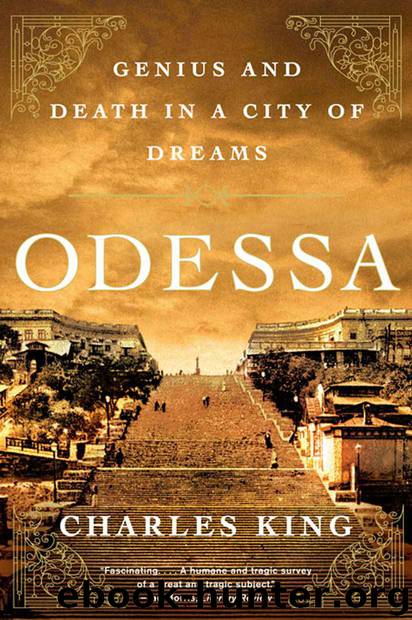Odessa: Genius and Death in a City of Dreams by King Charles

Author:King, Charles [King, Charles]
Language: eng
Format: epub, mobi
Publisher: W. W. Norton & Company
Published: 2011-02-28T00:00:00+00:00
CHAPTER 8
New World
Massacre on the steps: The famous baby carriage scene from Sergei Eisenstein’s 1925 film Battleship Potemkin. Goskino/The Kobal Collection.
Sailors and firemen were on strike for much of 1906 and 1907. Grain carters followed suit in 1910. Underground groups, although infiltrated by police informants, attracted party members and sympathizers in the port district and industrial suburbs, with political programs that ran from socialist to anarchist.
Shipping picked up after the end of the disastrous Russo-Japanese war but was hit again by the outbreak of a brief conflict between Italy and the Ottomans in 1911 and two wars in the Balkans in 1912 and 1913. When the Russian Empire entered the First World War in 1914, the city’s merchants had already lost entire fortunes in overseas commerce. The Ottomans’ decision to join as a German ally—a move that impeded traffic through the Bosphorus and Dardanelles straits—effectively brought business to a halt. With little to do and less to lose, stevedores and seamen, emboldened by ready supplies of vodka, contributed to the general malaise by regularly smashing heads as well as windows.
During the war the city lay near the geographical intersection of Europe’s old empires—Russian, Ottoman, and Austro-Hungarian—and of the new kingdoms, nation-states, and nationalities that were quickly spiraling away from their control. The city’s three largest ethnic groups—Russians at 39 percent, Jews at 36 percent, and Ukrainians at 17 percent—were ready audiences for political entrepreneurs marketing radically different visions of the future.
Odessans found themselves on multiple front lines: between Jews and their tormentors, between Ukrainian nationalists and their tsarist opponents, between radical Marxists and the forces of autocracy. But it was hard to tell which events heralded major changes and which might blow away with the next northeasterly wind. A visiting American physician observed in October of 1917 that all the ships in the harbor were suddenly flying red flags. “No one seems to know why, as we have not heard of any Naval Victory, nor is it a special holiday.”1 The doctor was witnessing Odessa’s version of the Bolshevik Revolution. Yet even that turned out to be of passing importance, at least in the short term.
Faced with horrible conditions on the battlefield and political revolutions in the imperial capitals, the Russian army collapsed over the course of 1917. Soldiers faded back into the civilian population, formed armed gangs and pitiful bands of beggars, or coalesced into the armies that eventually drew up on opposite sides of the Russian civil war—the Whites who remained loyal to the old order and the Reds committed to the ideals of revolution. The Central powers made plans to rush through the door that now opened on the eastern front. To block Germany, Turkey, or Austria-Hungary from gobbling up Russia’s industrial and shipping centers, the Entente powers divvied up responsibility for occupying portions of the old empire. British troops were dispatched to the east, to the Caucasus region, to secure control of the strategic oil fields of Baku. In Odessa a disheveled army of French colonial
Download
Odessa: Genius and Death in a City of Dreams by King Charles.mobi
This site does not store any files on its server. We only index and link to content provided by other sites. Please contact the content providers to delete copyright contents if any and email us, we'll remove relevant links or contents immediately.
| Africa | Americas |
| Arctic & Antarctica | Asia |
| Australia & Oceania | Europe |
| Middle East | Russia |
| United States | World |
| Ancient Civilizations | Military |
| Historical Study & Educational Resources |
A Tale of Love and Darkness by Amos Oz(819)
Aimee & Jaguar by Erica Fischer(806)
When Time Stopped by Ariana Neumann(785)
The Hare with Amber Eyes by Edmund de Waal(762)
Remember Us by Martin Small(714)
The Betrayal of the Duchess by Maurice Samuels(702)
A Chosen Few by Mark Kurlansky(691)
Genius & Anxiety by Norman Lebrecht(672)
The Invention of the Jewish People by Shlomo Sand(638)
Roosevelt and the Holocaust by Robert L. Beir(595)
East West Street: On the Origins of "Genocide" and "Crimes Against Humanity by Philippe Sands(569)
Angel of Auschwitz by Tarra Light(563)
Nazi Germany and the Jews, Volume 01: The Years of Persecution by Saul Friedlander(560)
The Aleppo Codex: A True Story of Obsession, Faith, and the Pursuit of an Ancient Bible by Matti Friedman(547)
The Warburgs by Ron Chernow(543)
The Kosher Capones by Kraus Joe;(521)
Genius and Anxiety by Norman Lebrecht(486)
Odessa: Genius and Death in a City of Dreams by King Charles(484)
Complete Works of Josephus by Josephus(482)
